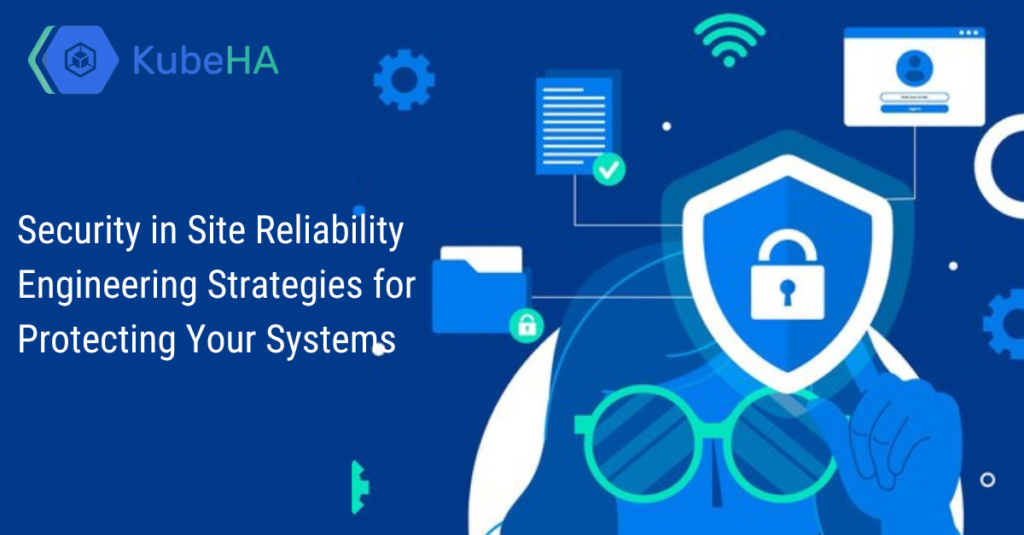
Site Reliability Engineering (SRE) practices are paramount. SRE, a methodology pioneered by Google, emphasizes the intersection of software engineering and IT operations to create scalable and reliable systems. However, amidst the pursuit of reliability and performance, security can sometimes take a back seat. In this blog, we delve into the importance of security in SRE and outline effective strategies for safeguarding your systems.
Understanding the Significance of Security in SRE
Security is not merely an add-on feature but an integral component of SRE. Neglecting security can lead to severe consequences, including data breaches, system downtime, loss of trust, and financial repercussions. In the context of SRE, security encompasses various aspects,
Data Protection: Safeguarding sensitive data from unauthorized access, tampering, or leakage.
System Integrity: Ensuring the integrity of systems and preventing unauthorized modifications.
Compliance: Adhering to regulatory requirements and industry standards to avoid legal liabilities.
Resilience: Building systems that can withstand security threats and recover gracefully from attacks.
Risk Management: Identifying potential security risks and implementing mitigation strategies proactively.
Strategies for Enhancing Security in SRE
Implementing Zero Trust Architecture: Adopt a zero-trust approach where every access attempt is rigorously authenticated and authorized, regardless of whether it originates from inside or outside the network. This mitigates the risks associated with insider threats and lateral movement by attackers.
Continuous Monitoring and Auditing: Employ robust monitoring tools and implement continuous auditing processes to detect anomalous behavior, security breaches, or configuration drifts in real-time. Automated alerts and response mechanisms help in addressing security incidents promptly.
Immutable Infrastructure: Embrace the concept of immutable infrastructure, where systems are built from pre-configured, unmodifiable components. This reduces the attack surface and minimizes the risk of configuration-based vulnerabilities and unauthorized changes.
Secure Development Lifecycle (SDL): Integrate security practices throughout the software development lifecycle, from design and development to deployment and maintenance. Conduct regular security assessments, code reviews, and vulnerability scans to identify and remediate security flaws early on.
Chaos Engineering for Security: Utilize chaos engineering principles to proactively simulate security incidents and assess the resilience of systems against potential attacks. By intentionally injecting failures and security breaches in a controlled environment, organizations can identify weaknesses and strengthen their defenses.
Immutable Logs and Forensics: Ensure that logs and audit trails are tamper-proof and immutable to preserve their integrity for forensic analysis in the event of security incidents. Centralized logging and robust log management solutions facilitate efficient monitoring, analysis, and investigation.
Incident Response and Disaster Recovery: Develop comprehensive incident response plans and disaster recovery strategies to minimize the impact of security breaches or system failures. Conduct regular tabletop exercises and simulations to validate the effectiveness of these plans and refine them accordingly.
Key Strategies for Protecting Your Systems
1. Implementing Proactive Threat Monitoring and Incident Response
An effective security posture begins with proactive monitoring to detect and mitigate potential threats in real-time. Leveraging advanced monitoring tools and technologies enables SRE teams to identify anomalies, suspicious activities, or vulnerabilities promptly. Additionally, establishing a robust incident response framework ensures swift action in the event of a security breach, minimizing the impact on system reliability and user experience.
2. Embracing a Culture of Security Awareness
Promoting a culture of security awareness among team members is instrumental in mitigating human errors and vulnerabilities. Conducting regular security training sessions, workshops, and simulations cultivates a vigilant mindset across the organization, empowering employees to recognize and respond to security threats effectively. Moreover, fostering open communication channels encourages proactive collaboration between SRE and security teams, fostering a unified approach towards mitigating risks.
3. Enforcing Least Privilege Access Controls
Adopting a least privilege access model restricts user privileges to the minimum necessary for performing their roles effectively. By implementing granular access controls and privilege escalation mechanisms, SRE teams can mitigate the potential impact of insider threats and unauthorized access attempts. Additionally, enforcing strong authentication mechanisms, such as multi-factor authentication (MFA), enhances the overall security posture of the system.
4. Leveraging Automated Security Testing and Compliance Audits
Integrating automated security testing into the CI/CD pipeline facilitates early detection of vulnerabilities and compliance deviations. By conducting regular security scans, vulnerability assessments, and compliance audits, SRE teams can identify and remediate security gaps proactively. Furthermore, leveraging infrastructure as code (IaC) principles enables automated provisioning and configuration management, ensuring consistency and compliance across the entire infrastructure.
5. Continuously Evaluating and Improving Security Posture
Security is an ongoing process that necessitates continuous evaluation, refinement, and adaptation to emerging threats and evolving compliance requirements. By conducting regular security assessments, penetration testing, and post-incident reviews, SRE teams can identify areas for improvement and implement targeted remediation measures. Additionally, staying abreast of industry best practices, emerging technologies, and regulatory changes enables organizations to enhance their security posture proactively.
Site Reliability Engineering practices is essential to safeguarding the integrity, availability, and confidentiality of digital assets. By adopting proactive threat monitoring, fostering a culture of security awareness, enforcing least privilege access controls, leveraging automated security testing, and continuously evaluating and improving security posture, organizations can fortify their systems against evolving cyber threats. Embracing security as a core tenet of Site Reliability Engineering Follow KubeHA Linkedin Page KubeHA